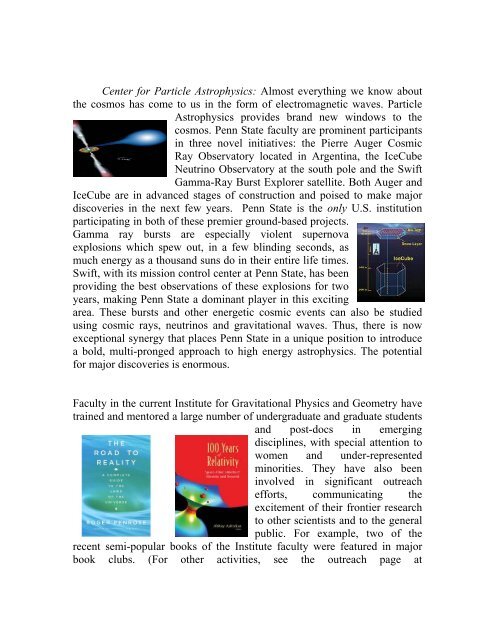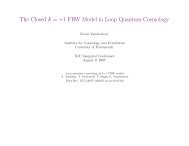Institute for Gravitation and the Cosmos (IGC)
Institute for Gravitation and the Cosmos (IGC)
Institute for Gravitation and the Cosmos (IGC)
Create successful ePaper yourself
Turn your PDF publications into a flip-book with our unique Google optimized e-Paper software.
Center <strong>for</strong> Particle Astrophysics: Almost everything we know about<br />
<strong>the</strong> cosmos has come to us in <strong>the</strong> <strong>for</strong>m of electromagnetic waves. Particle<br />
Astrophysics provides br<strong>and</strong> new windows to <strong>the</strong><br />
cosmos. Penn State faculty are prominent participants<br />
in three novel initiatives: <strong>the</strong> Pierre Auger Cosmic<br />
Ray Observatory located in Argentina, <strong>the</strong> IceCube<br />
Neutrino Observatory at <strong>the</strong> south pole <strong>and</strong> <strong>the</strong> Swift<br />
Gamma-Ray Burst Explorer satellite. Both Auger <strong>and</strong><br />
IceCube are in advanced stages of construction <strong>and</strong> poised to make major<br />
discoveries in <strong>the</strong> next few years. Penn State is <strong>the</strong> only U.S. institution<br />
participating in both of <strong>the</strong>se premier ground-based projects.<br />
Gamma ray bursts are especially violent supernova<br />
explosions which spew out, in a few blinding seconds, as<br />
much energy as a thous<strong>and</strong> suns do in <strong>the</strong>ir entire life times.<br />
Swift, with its mission control center at Penn State, has been<br />
providing <strong>the</strong> best observations of <strong>the</strong>se explosions <strong>for</strong> two<br />
years, making Penn State a dominant player in this exciting<br />
area. These bursts <strong>and</strong> o<strong>the</strong>r energetic cosmic events can also be studied<br />
using cosmic rays, neutrinos <strong>and</strong> gravitational waves. Thus, <strong>the</strong>re is now<br />
exceptional synergy that places Penn State in a unique position to introduce<br />
a bold, multi-pronged approach to high energy astrophysics. The potential<br />
<strong>for</strong> major discoveries is enormous.<br />
Faculty in <strong>the</strong> current <strong>Institute</strong> <strong>for</strong> <strong>Gravitation</strong>al Physics <strong>and</strong> Geometry have<br />
trained <strong>and</strong> mentored a large number of undergraduate <strong>and</strong> graduate students<br />
<strong>and</strong> post-docs in emerging<br />
disciplines, with special attention to<br />
women <strong>and</strong> under-represented<br />
minorities. They have also been<br />
involved in significant outreach<br />
ef<strong>for</strong>ts, communicating <strong>the</strong><br />
excitement of <strong>the</strong>ir frontier research<br />
to o<strong>the</strong>r scientists <strong>and</strong> to <strong>the</strong> general<br />
public. For example, two of <strong>the</strong><br />
recent semi-popular books of <strong>the</strong> <strong>Institute</strong> faculty were featured in major<br />
book clubs. (For o<strong>the</strong>r activities, see <strong>the</strong> outreach page at








